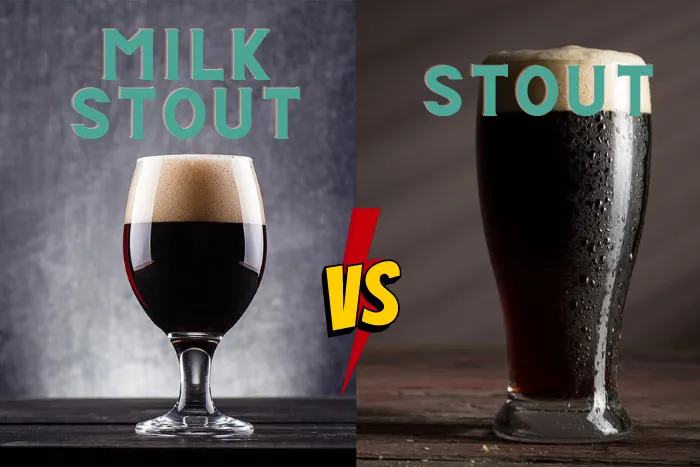With a wide range of flavors and styles, beer drinkers have an array of choices to pick from – one such option being milk stout versus stout. One of the most popular types is milk stout vs stout. Milk stouts have a distinct flavor, while stouts are stronger and have more alcohol.
We’ll discuss milk stout and stout beers’ origins, fermentation ingredients, and popular brands in this blog post. We’ll also compare these two beers’ pros and cons so you can choose which one suits your taste.
Table of Contents:
- Origins and History of Milk Stout and Stout Beers
- Ingredients Used in Milk Stout and Stout Beers
- Fermentation and Brewing Process for Milk Stout and Stout Beers
- Popular Brands to Try – Pros & Cons of Drinking Milk Stout vs Stout Beers
- FAQs in Relation to Milk Stout vs Stout
- Conclusion
Origins and History of Milk Stout and Stout Beers

The origin of milk stout beer can be traced back to the late 19th century when brewers began experimenting with adding lactose, a type of sugar derived from cow’s milk, to their beers. The resulting sweet and creamy flavor was well-received by consumers and quickly became popular in England. Brewers combined malted barley, hops, water, and lactose to create the sweet and creamy taste of milk stout beer. This style of beer has since spread around the world and is now enjoyed in many countries.
Stout beer has an even longer history than its milky cousin. Its roots can be found in porters – dark ales that originated in London during the 18th century. These porters evolved into full-bodied stouts with bitter hops and roasted malt or barley for flavor and color.
Hops are also used for bitterness but generally not as heavily as other styles such as IPAs or pale ales. Stouts range from dry Irish stouts to sweet Russian Imperials and everything in between.
Changes in taste and brewing technology have helped producers create new flavors faster for these two types of beer. Craft breweries are adding coffee beans, chocolate, spices, and fruit juices to milk and stouts to add complexity and depth.
Ingredients Used in Milk Stout and Stout Beers
Stouts are generally concocted from a blend of malted barley, toasted malt, hops, and water. Roasted malt is what gives stout beers their signature dark color as well as flavors like coffee or chocolate. Hops add aromas and flavors and balance the sweetness of roasted malt. Oats may also be added for texture or flavor complexity but this isn’t always necessary for traditional stouts.
Milk stouts and stouts share many ingredients, but some distinguish them. Lactose, which is not in regular stout beers, adds sweetness and body to milk stouts without increasing bitterness like certain grains would.
Furthermore, oatmeal can be added to either type of beer during the brewing process; this will give a silky smoothness along with hints of nuttiness when done correctly but should only be used sparingly since it can easily overpower other flavors present in these styles of beer if overused.
Overall, milk stouts and stouts have many common ingredients as well as some unique ones that make them distinct. Let’s now examine the brewing techniques used to create each of these beers and how they differ.
Fermentation and Brewing Process for Milk Stout and Stout Beers
Brewing beer is a complex process, and the fermentation and brewing processes for milk stouts and stouts are no different. It’s essential to comprehend the components employed in each beer variety for understanding these brewing and fermenting processes.
Mashing involves immersing grains in hot water to hydrolyze starches into fermentable sugars, followed by boiling the mixture with hops for sanitization and adding bitterness.
The distinguishing factor between milk stout beer and regular stout is the fermentation process; while lactose sugar remains intact during the fermentation of a milk stout providing sweetness, most of this sugar gets fermented away when making a regular stout resulting in its characteristic roasted flavor from darkly kilned malts.
The fermentation and brewing process for a milk stout and stout beers is a complex yet rewarding task that can be tailored to the individual’s preference. Next, we will explore some popular brands of both beer types as well as the pros and cons associated with each one.
Popular Brands to Try – Pros & Cons of Drinking Milk Stout vs Stout Beers

Popular Brands to Try – Milk Stouts
The creamy, velvety texture of milk stouts can make them a more palatable choice for some beer drinkers compared to traditional varieties. Nevertheless, for those who prefer more bitter notes in their beer, the sweetness of milk stouts may be off-putting.
There are a variety of milk stouts available on the market, including Samuel Smith’s Organic Chocolate Stout, Left Hand Brewing Company’s Milk Stout Nitro, and Oskar Blues Brewery’s Death by Coconut. These beers possess a velvety consistency and sugary taste that sets them apart from regular stouts.
Popular Brands to Try –Stout Beers
Popular brands of stout beer include Guinness Draught, Sierra Nevada Narwhal Imperial Stout, and Founders Breakfast Stout. These brews boast strong tastes, with hints of java or cocoa, and tend to be higher in booze than other kinds of beer.
The main benefit associated with drinking stouts is their intense flavor profile which can range from malty sweetness to roasted bitterness depending on the type chosen. Consuming stouts with their high alcohol content should be done responsibly to ensure a safe and enjoyable experience.
FAQs in Relation to Milk Stout vs Stout
What’s the difference between stout and milk stout?
Stout and milk stout are both dark beers, but there is a difference between them. Stout beer is made with roasted malt or barley, hops, yeast, and water. It has a strong flavor profile of coffee or chocolate notes as well as bitterness from the hops.
The milk stout is also made with these ingredients plus lactose sugar which gives it a sweeter taste than regular stout beer and makes it slightly creamier in texture. The color can range from deep brown to black depending on the type of malt used during production.
What makes a stout a milk stout?
A milk stout is a type of stout beer that contains lactose, which is a sugar derived from milk. The addition of lactose makes the beer sweeter and creamier than traditional stouts, giving it its signature flavor profile.
Milk stouts are often darker in color and have notes of coffee, chocolate, caramel, and toffee. Lower alcohol levels than other beers are often seen due to the sweetness added by lactose.
What’s the difference between Guinness and milk stout?
Guinness is an Irish dry stout made from roasted barley, hops, water, and yeast. Guinness has a velvety feel and slight tartness that give it its distinctive taste. Unlike Guinness, Milk stouts are brewed with lactose sugar to provide sweetness, body, and mouthfeel. The added sweetness makes milk stouts less bitter than Guinness so they tend to be more approachable for those who don’t like overly bitter beers.
Is Milk Stout healthier than beer?
No, milk stout is not necessarily healthier than beer. Dark beers such as stouts may contain more antioxidants and minerals due to the roasted malts, however, this does not necessarily mean they are healthier than other beer varieties.
Milk stouts also contain higher levels of calories and carbohydrates compared to other types of beer, so it can be less beneficial for those looking to watch their weight or calorie intake. No beer is the healthiest, so moderation is best.
Conclusion
In conclusion, milk stout and stout beers have a long history that can be traced back centuries. They differ in ingredients used, fermentation process, and brewing techniques which leads to differences in flavor profile, color, alcohol content as well as IBU level. Milk stouts are sweeter than traditional stouts with less bitterness while still having a creamy texture due to the addition of lactose sugar during the brewing process. Popular brands such as Guinness Draught Stout and Left Hand Milk Stout Nitro offer distinct flavors for beer lovers alike so it is worth trying both styles before deciding on your favorite.
Discover the difference between milk stouts and regular stouts with Brew Publik‘s expert beer reviews, guides on beer equipment, subscription services for craft beers, and resources to make your own brew. Join us now to get a taste of something special!

